How to Make Pâte Sucrée
When setting out to make a tart the French way (and most pastry chefs do) you’ve got two basic choices in dough: pâte brisée or “short dough“ and pâte sucrée, or “sweet dough”. Sweet dough is both richer and sweeter than short dough, which means it’s more tender, but it’s still firm enough to hold its shape when cut into slices and served.
What’s the difference between tart doughs and pie crusts? you might well ask. It’s a good question, because the ingredient proportions can be strikingly similar: lots of butter relative to the flour. One big difference is the amount of sugar that’s added. Pie crusts contain very little (if any) sugar. Tart doughs call for quite a bit, usually in powdered form to speed its incorporation into the dough (crystal sugar can cause graininess). Tart doughs also usually call for eggs (or egg yolks) and cream.
The big process difference between the two is that whereas pie crusts are usually made by hand, tart doughs are made (ideally) in a food processor. I should insert the obvious here: food processors are not an authentic part of the tart-making process. However the spinning blades give tart dough a uniformity of texture that’s very hard to replicate by hand. And that uniformity, once the rolled crust is put into the oven, helps prevent cracking and the loss of precious filling.
There are a lot of recipes out there for pâte sucrée, and a lot of people expend a lot of energy arguing over which one is more authentic than the other. This one just happens to be my favorite. The formula is:
1 egg yolk
2 tablespoons heavy cream
½ teaspoon vanilla extract
1 ½ cups (7.5 ounces) all-purpose flour
3 ounces powdered (confectioner’s) sugar
¼ teaspoon salt
9 tablespoons (4 ½ ounces) butter, cold
Begin by combining the egg yolk, cream and vanilla in a bowl.
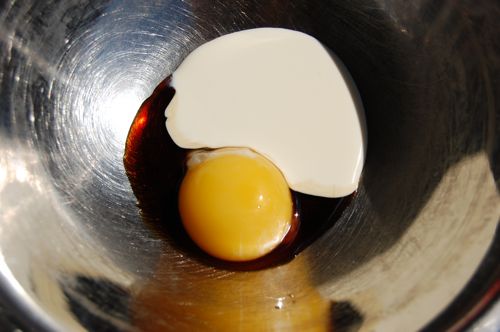
Wreck it.
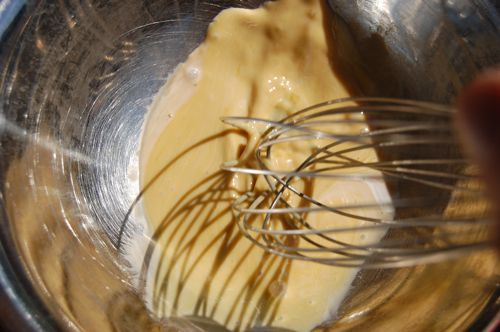
Now combine the dry ingredients in the bowl of a food processor fitted with the plastic pastry blade, and process for 30 seconds or so until they’re blended.
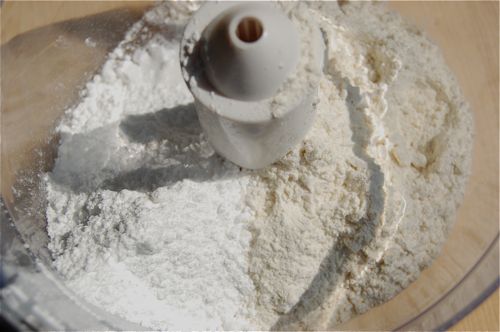
Add the cold butter and pulse for one or two seconds at a time until the butter is incorporated (it could take a couple of dozen pulses).
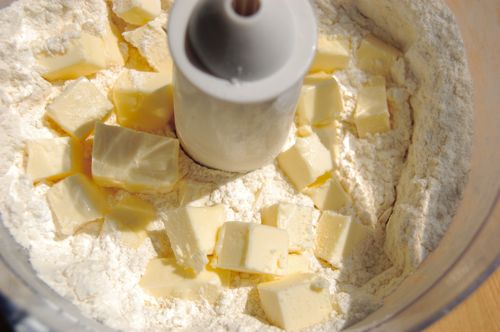
Yes, I forgot to take a picture of that phase. Oopsie. Now then, with the motor running, add the egg mixture. Wait for the mixture to collect into a single mass — then stop the machine immediately. It should look about like this:
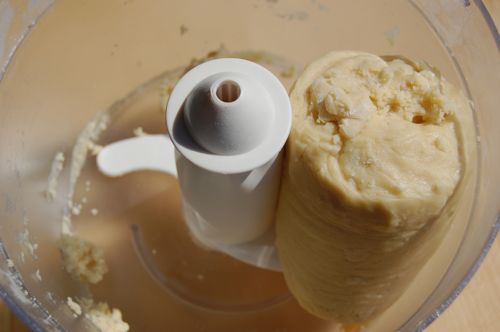
Pat the dough into a disk, wrap it in plastic and put it into the fridge for a minimum of an hour, maximum of two days.
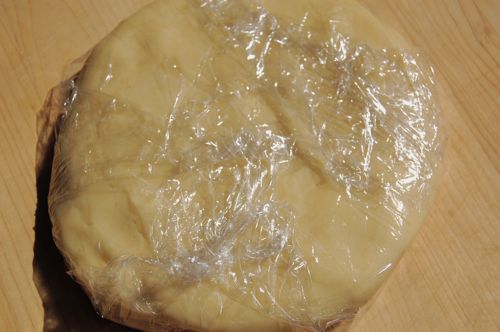
Freeze it for up to two months. There, that was easy, wasn’t it?
Does this yield 2 or 3 tarts?
Hey Lezlie!
It depends on the size! I use this for one large 10″ or 11″ tart. Honestly, I’m not sure about smaller ones…I need to come up with some portions for that!
– Joe
Hi Joe,
My food processor only comes with the standard steel blade. Is it OK to use or should I look for a plastic one? Thanks!
Yes, a steel blade is fine. In fact I use the steel one almost exclusively. It should work well, even for dough.
– Joe
Hello!!
I made this tart shell. I have made two 7 inch tart shells. I am not sure if I did it right or wrong. After I baked the tarts, it resembles more of a biscuit shell. Is it how the texture of the tart shell is meant to be? Like a biscuit. It is now in the fridge, waiting to be filled.
I would like to fill it up with chocolate mousse. I was wondering, if I add orange juice or raspberry juice and smashed raspberry in the melted hot chocolate. Will the chocolate seize? Since I have two tart shells, I would like to make mousse two ways: 1) adding eggs to my mousse – using the recipe I found in your website (2) beating (1 cup) whipping cream to stiff peak and adding (112 grams) of dark chocolate that will be melted over simmering water. For both the methods, adding smashed fruits and juices, will the chocolate seize?
If the answer is “NO, The Chocolate will be perfectly FINE, IT WILL NOT SEIZE” 🙂 Could you please tell me the amount of juice and smashed raspberries I should add in grams measurement? When should I add smashed fruits and juices to the chocolates? Should I add the smashed berries and juices to the raw chocolate or after the chocolate has been melted? I love mousse. I love terry’s chocolate orange and smashed raspberry flavored dart chocolates . I have been eating a lot of chocolate mousse. Now, I am thinking if I could add some fruity flavors to my chocolate mousse.
Thank You!!!
Hi Khan!
It sounds like you did it right…it should be something like a biscuit. Regarding the fruit, definitely do not add them to the melted chocolate as the juice absolutely will cause the melted chocolate to seize. However you can certainly try folding in some fruit after you have finished the mousse. That should not be a problem. As for the amount, you can add as much as you want as long as you are satisfied with the texture. Let me know how it goes!
– Joe
Hello!!!
I added fresh raspberries. I did not squish them. I gently folded them. I was afraid that, what if the juices from the squished raspberry, makes my chocolate seize and the whipping cream curdled. It is the same reason I left out the orange. I did not add orange to the chocolate mousse tart. If the raspberry do get seized, it might as well be inside the mouth of people eating them. When I ate the raspberry chocolate mousse, to me it tasted fine. I nicely leveled out the raspberry chocolate tart and decorated with raspberry on top, going round all the way in the center. Sprinkled with edible gold sprinkles. It looked very pretty.
I also really really really really appreciate your prompt, quick responses. It saves the dishes from a lot of disasters waiting to be happened. It also helps me a lot and tremendously on my cooking techniques. Also importantly on the time, because if I added squished raspberry and orange juice on the hot molten chocolate. It would have gotten seized and I would not have had the time to make a new one.
Thank You!!!!!
It’s my pleasure, Khan!
Get back in touch if I can help in any other way.
– Joe
Hi Joe!
Thank you so much for directing me here! I made this just now, and the result is soooooooo yummeeehhhh…. Hahahahahaha… thank you, thank you, thank you….
Midia.
So glad it worked, Midia! And it is my very great pleasure!
– Joe
oh my, oh my oh dang!
Here I go again–today I will try a Lemon Sabayon Tart. I will do ok with the sabayon as I have done this before. What I am still having problems with is the crust! !!
When I used this recipe:
7.4 oz flour
2oz sugar
1 stick butter
1 large yolk
2T heavy cream
I used my food processor, and though I got to the part before the cream and yolk–the part with just the flour,salt, sugar, and butter. I got to the place where there are big clumps and little clumps, added the yolk and cream and all I get is a sandier mess. I then added more cream a little bit at a time (2 TB) just to hold it together well enough to dump onto the waxed paper. There was still a large pile that was too dry to hold together. I just crammed it onto the little piles that were sticking and put it in the refrigerator. This is the same problem I am having pie dough. I don’t seem to be able to get the necessary amount of moisture in to hold all of it together.
Questions:
1. we live up here in the high rockies (dry and cold)–is my kitchen much drier than I think it is?
2. I pulse the machine only about 3 times on/off and can get the butter flour to look good (big clumps and little grainy bits). Then when I add the liquid and pulse two more times–it never comes together–even when I add waaaay too much more liquid!
Should I pulse fewer times and stop before I get to the ideal clumps?
3. Should I give up and just buy Costco? (NO that is not an option!!)
Thank you again,
Hi Annalee!
Sorry to hear about he troubles! This recipe seems a little bit lean to me, but not so lean that it should behave that way. If your environment is very, very dry it stands to reason that your flour would be a little extra dry, so that might account for some of the problem. You might try mine, which has a little more butter but is quite similar:
http://joepastry.com/category/pastry-components/tart-crust/sweet-tart-crust/
My suggestion is that you not be afraid to process it some more. Tart crust is not like pie crust in that you have to worry about over-agitation. It’s supposed to be smooth and well-blended. If you have to add extra moisture, go ahead and do it in the interest of bringing it together. Just be sure you rest the dough well later on and all will be well!
Cheers,
– Joe
Yes, just as I expected it would–the crust turned out to be very tough!
Please help!
Hey Annelee,
Sorry, just saw this after I answered the other one. So was it crumbly or just tough? That will help me. You may need a little more fat…and pastry flour instead of all-purpose might well help the cause.
– Joe
When I turned it out of the processor on to the board it was way too crumbly! I then added more cream so it would stick together. Finally, got it to stick together, but the end result was like a board!
As I mentioned, I have the same problem with pie dough. Although sometimes I do get lucky and it turns out wonderfully flaky–I just don’t understand why!
Question: Do you suppose it would be good to think about the temperature of the butter like this–Tender butter equals tender crust? In my mind I think perhaps my butter is too cold, but on the other hand every recipe tells you to keep bowl, flour, hands, water, and butter COLD! I remember at the demonstration I went to she showed us that butter you could leave fingerprints in just slightly was the right temperature. Could this be the problem?
Thank you for the extremely helpful instructions and even more for the background that helped me understand what I was doing (confidence building). Used your recipe for tarts for a birthday party for my husband last weekend, and they came out beautifully.
I’d only made savory tart crust before. Thanks for taking the stress out trying something new.
Cath, you made my day! Thanks so much for a delightful comment. I love what I do — glad the instructions were so helpful.
Cheers,
– Joe
First off, thanks a bunch. This is the first pâte sucrée recipe that I’ve found that isn’t horrible to work with (I suspect the cream might be the key). The end result is delicious and crumbly. There’s a slight visible flakiness to the crumbs, maybe maxing out at around 1/8″ across. But the dominant texture is crumbly, not solid flakes.
But.
Of the dozen slices I cut from a 25cm tart, only one didn’t have at least one crack right across it, and at least half had the lip break off entirely. There weren’t, as far as I could tell, any weak/thin spots in the pastry where the cracks occured – there wasn’t a single patch needed while rolling out, much to my delight.
The only thing I can think of is that it was slightly overcooked, and thus more brittle. It was certainly more of a nutty brown than the image shown on your techniques page for prebaking. Is a lighter bake likely to be the answer?
The other option is that I’ve missed something in translation. I’m down in Australia, and we have different names for flour and cream and the like.
Heavy cream, as far as I could tell from the internet, is 35% fat. Correct? What we call heavy cream down here ranges 45 to almost 60.
What’s the gluten content of the AP flour you use? I understand that it varies a bit across the US. I’m working with about 10.5-11% for “plain” flour, which is, as best I can tell, the equivalent. Though, given that the texture of my base was nice and light and crumbly, I’d be surprised if gluten was the villain here.
Any advice or suggestions you could offer would be greatly appreciated.
Chris
HI Chris!
I think the answer is definitely the degree of browning. Ingredient-wise, we’re more or less at parity, both with fat content and gluten. When tart crusts turn brown to the degree you’re describing they get flaky to the point that they fall apart — but of course I don’t need to tell you that!
A perfect tart crust is going to be blonde all over save perhaps for the very top edge. Sorry if I didn’t make that clearer, Best of luck with the next one. Keep up the great work!
Cheers,
– Joe